Having early traction is a sign that you have a product that people want to use. Also, early startup traction acts as insurance for VCs and their investment.
The goods news is that you don’t need a lot of money for early startup traction.
But you are going to need that traction to make some money!
What is early startup traction?
Early traction refers to your first wave of users. Those early adopters are crucial.
The reason is that although they haven’t heard anything about you, they still give you some of their precious time. That means that they saw value in your product; a solution to their problem.
Moreover, those people are the ones who will most likely be your first ambassadors, bringing their friends along to try out your product or service.
Factors of getting early traction
In a world where everybody wants to be a billionaire, little to none give a deep thought to what could possibly earn them a qualitative, first wave of users.
Yes, quality over quantity!
E.g., Let’s say you’ve built a Social Media Automation tool for non-professionals (a.k.a. Average Instagram celebrity wannabe ). It’s only natural that the core elements of your product were built for this exact demographic. Acquiring social media managers will never work for you as it’s sure that they are looking for a far more sophisticated solution than your software offers.
Silly example, but I guess you get my point.

So what are the main factors of getting that first wave of users inside?
- Your product solves a problem that a certain set of people face. Uber saves time & Airbnb finds you a cheap and nice place to crash.
- You have an amazing branding along with a story that people relate to. Don’t think of “story” like a fairytale or something. It has more to do with the language you use and how you present yourself.
Casey Neistat, for example, presents himself as a school dropout that followed his passion for filmmaking. Everything that he produced so far revolves around the story he wants to show. The struggle, the DIY attitude, the plain language. Even his biggest commercial successes had those characteristics; Like this NIKE advertising (which is stunning btw):
- Great UX. How many times did you use a very complex app before deleting it? Not too many, I guess. Even if your app gave users an instant six-pack, no one would use it again if it was difficult for them to take action (ok, they would try harder if it was for an instant six-pack).
[clickToTweet tweet=”Remember that nothing beats a good first impression. #UX” quote=” Remember that nothing beats a good first impression.”]
As DesignHack puts it:“User experience is just as important as a visual identity. Seriously. It doesn’t matter what your site or app looks like if people don’t know how to interact with it. And moreover, they need to enjoy that interaction.” - Unparalleled Support. People like to be independent until they need help. Amazing customer support is often overlooked, as everybody is consumed by building new features that will trick people into staying. “But what is considered as great customer support?” Honestly, there’s no right answer to that. You can start by being polite and then eventually learn how to deal with angry customers on social media.
5 tactics for early startup traction can do Right Now
I bet that this is the part of the article that you came for. Come on; admit it!
You can’t cut corners to success, and there’s no golden recipe. But I promise that there are ways you can build a stack of early users if you aim your efforts in the right direction.
[clickToTweet tweet=”You can’t cut corners to success, and there’s no golden recipe. #traction #startup” quote=”You can’t cut corners to success, and there’s no golden recipe. #traction #startup”]
1. Ensure You Have Product-Market Fit
As a basic definition, you have P/M fit when people who know they want your product, are happy with what you’re offering.
“Product/market fit means being in a good market with a product that can satisfy that market.” – Marc Andreessen
“Good” meaning that the market size is large enough to sustain a business.
Practically, product/market fit just means you have a product that the market loves and can’t live without.
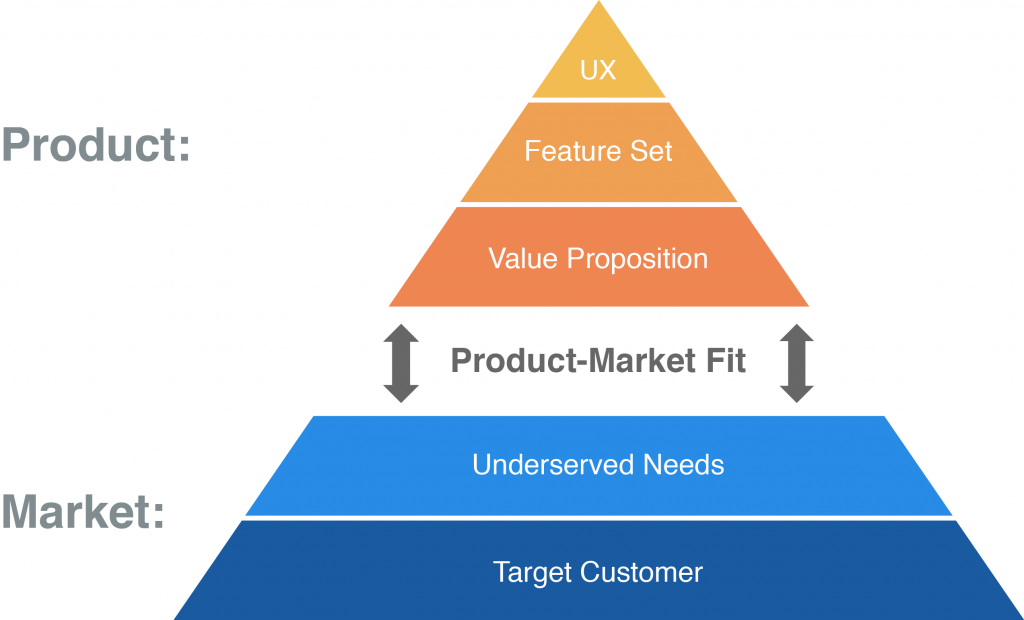
Achieving Product-Market Fit can be interpreted as having the right funnel, and having each step of the funnel fine-tuned so that it effectively converting traffic and reach into sales.
The Funnel consists of 5 steps or KPI’s that allow us to turn Reach into actual Sales. These KPI’s are:
- Reach (which can be Organic, Paid, or Social)
- Traffic (the number of visitors on your website)
- MQL (Marketing Qualified Leads)
- SQL (Sales Qualified Leads)
- Sales ($, €, ¥, ₿)
For each KPI or step of the funnel, you should have Metrics that prove the level of success you’ve achieved on every step.
You should also have particular Criteria that are critical to the success of every step of the Funnel. These criteria will be turned into the Action Plan for achieving Product-Market Fit. We have further defined them for each step of the funnel.
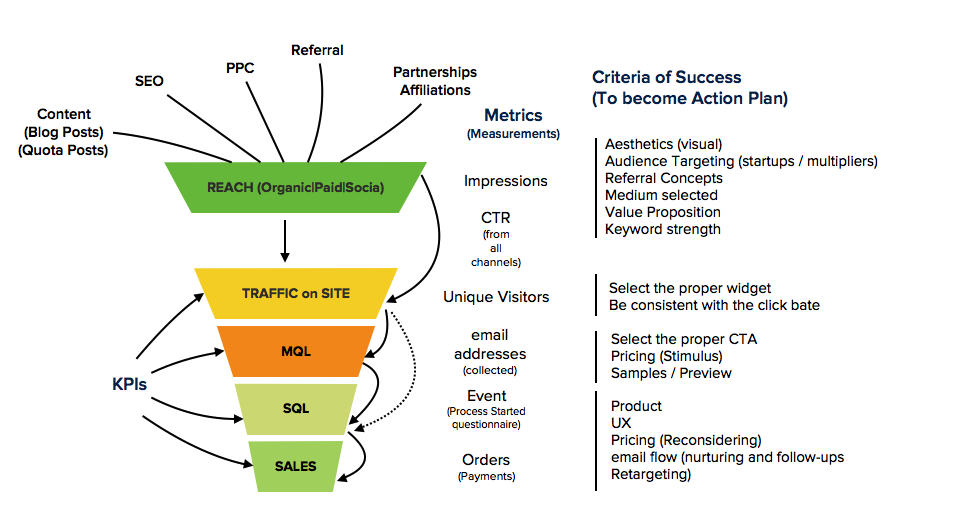
2. Start A Pre-Launch Campaign
Building a product is tough. During the process you invest time (taken from family, friends, traveling), money and resources- You know you can’t afford to make such a sacrifice for nothing!
Many businesses launch in an unexplored area, resulting in no traction.
“But, what went wrong?” The answer is rather simple: Nobody was anticipating your launch or even knew about it.
The guys at RobinHood knew very well what it means to be a goldfish thrown to the ocean. That’s why they decided to build an EPIC pre-launch campaign, attracting more than 300K people waiting to sign up!
So, what can YOU do, to launch your EPIC pre-launch campaign that will deliver a wave of early adopters for your product?
I think my good friend, George Vasiliadis, wrapped it up pretty nicely in his article about boosting pre-launch campaigns.
How to Boost a pre-launch campaign for early startup traction
1. Build a pre-launch landing page
A landing page is the window of your product to the world. It can assist you in delivering the right message to the right audience.
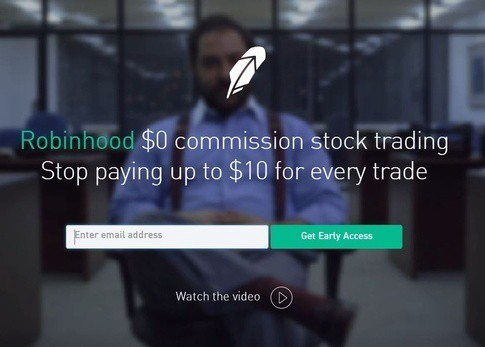
If you want a Robinhood-style pre-launch campaign, you can try our weapon of choice, which is no other than Viral Loops!
2. Run a pre-launch campaign to get more leads with a viral boost
In that pre-launch stage, all you need is to get emails, as many emails as you can. Get people to love you.
Turn early-visitors into ambassadors of your product. When someone lands on your website (s)he can join a waitlist or a giveaway where she can get early access if she refers her friends.
3. Boost traffic with ads
This is the most scalable and easiest way to test different campaigns and get immediate results.
It’s necessary to run campaigns on paid channels because they’re highly customizable and you can easily target and test specific groups of people.
4. Have a banner with every important referral page
Customize your landing pages by adding welcoming banners and widgets to users from a range of referral sources.
5. Submit your startup (ProductHunt, HackerNews, Betalist)
There are several websites where you can expose your startup and build backlinks. Have you tried Product Hunt? Betalist? Hacker News?
You can find all the necessary communities to list your startup using PromoteHour.
If you don’t have time to submit your startup, you can have a look at StartupLister, which helps you submit your information to startup directories, review sites, and communities
6. Build/engage with a community
One of the cheapest ways to create momentum for your product is to build a community around your startup.
A community is much more than a one-time marketing campaign and can help you throughout your company’s life cycle if you give the time to grow it right.
Here’s a great guide for building awesome communities, created by Sacha Greif.
7. Building marketing into your product
“Marketing is for companies with sucky products”
– Fred Wilson, VC
Dropbox, Hotmail, Eventbrite, Mailbox, and Snapchat acquired millions of users with almost no money spent on marketing. They just built virality into their product.
A startup’s ability to go viral depends on two variables: time and the ‘viral coefficient,’ i.e., the number of new users each user generates. The graph below illustrates startup growth at different rates based on different viral coefficients. Let’s say that the Y-axis represents your number of user signups, and the X-axis represents time. If your viral coefficient is 1.0 (each user generates one new user), you will achieve linear growth, assuming you retain your users. If you have a viral coefficient above 1.1, you will achieve exponential growth as illustrated by all of the lines above the lower green line.

3. Crowdfund Your Product
Crowdfunding has presented a significant change in how people bring their products to life. Platforms like IndieGoGo and Kickstarter, offer the ground for people to discover new products and invest to bring them to life.
This acts as a perfect opportunity to attain early traction, as people that choose to invest in your product crave to use it!
There are a few things you should keep in mind about crowdfunding your business:
- Most crowdfunding campaigns fail.
- A high percentage of donations come during the first days of the campaign.
- You should set a realistic goal for your campaign.
- Choosing the right crowdfunding platform is vital.
- Don’t promise things you can’t deliver.
4. Build An Email List
I love email! Most of us, use email more than we use our home phone.
Now and then, there are voices saying that email marketing is dead and similar email marketing myths.
Noah Kagan has famously asked: ”After you wake up what is one of the first things you do in the morning?” — checking your emails, of course!
Back to building an email list, one thing you should avoid the plague is buying an email list. What you should do instead is build your email list.
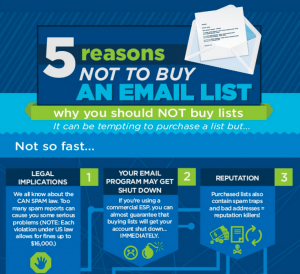
(Source)
Although email marketing is important in every stage of a business, it’s crucial for early traction as it allows you to communicate your culture, story, and goals directly to your early adopters and, more importantly, get them back to your website or app!
Now, to start getting email addresses immediately, you only need 3 things:
- An email capturing mechanism.
- An email marketing platform.
- Something to give people in return for giving their email addresses.
For capturing emails, you can use tools such as Appocalypsis or SumoMe. They both offer a lot of options in pop-up windows and website widgets.
As far as it concerns the email marketing platform, I use and trust MailChimp for a few years now, and I would stop using it only in case they turned this baby into complete trash (not very possible).
In case you want a broader selection of tools, I’ve written a survival guide for growth hacking tools in the past, which
As I previously mentioned, you also need something to give in return to people for their email addresses.
This could be:
- A case study
- An eBook
- A discount
- The promise of delivering only amazing things in their inbox.
Be cautious! Don’t use those email addresses only to push promotions; you’ll probably end up with a huge bounce and unsubscribe rate.
Instead, try to create and deliver content that people can’t resist! Recently, I started delivering a new email only to the subscribers with a high rating (people that open and interact with most of our emails).
In those emails, I try to start a conversation, asking people what they’re up to and also offer my help. Along with that, I share some interesting articles or video I read/watched during the previous week.
This is what the email looked like:
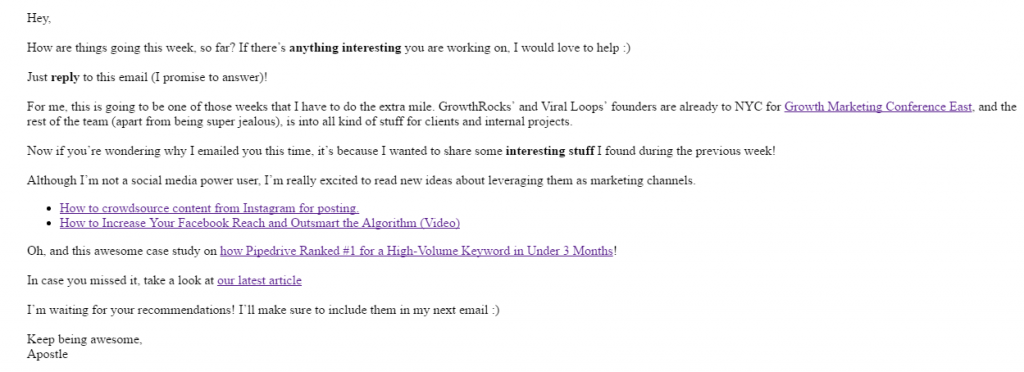
And here’s how it performed:

Those stats are incredibly high for a marketing newsletter, don’t you think?
5. Integrate A Referral Program
Why pay for new users, when you can reward your existing ones for bringing them to you?
Integrating a referral program in your marketing plan ensures the activation of a new (and very cheap) acquisition stream.
That way you can reward your existing users with different prizes, depending on the number of new users referred by them. The prizes could be literally anything, but the best practice is to use things from inside your product; just like Dropbox did!

E.g., If you have a free game with in-app purchases, you can reward your users by giving them some premium items.
You only need 3 things to build a referral program:
- An easy-to-use platform (did I mention Viral-Loops??)
- Find what kind of action you want to reward your users with
- What kind of reward you will offer
And as soon as you build your referral program, you can read this guide about 7 Ways To Promote Your Referral Program.
Conclusion
I hope this article gave you a deeper understanding of early startup traction and how to attain it. I would love to hear some stories from founders and marketers, and startup marketing agencies.
What would you do to get early startup traction?
Cheers 🙂

Theodore has 20 years of experience running successful and profitable software products. In his free time, he coaches and consults startups. His career includes managerial posts for companies in the UK and abroad, and he has significant skills in intrapreneurship and entrepreneurship.
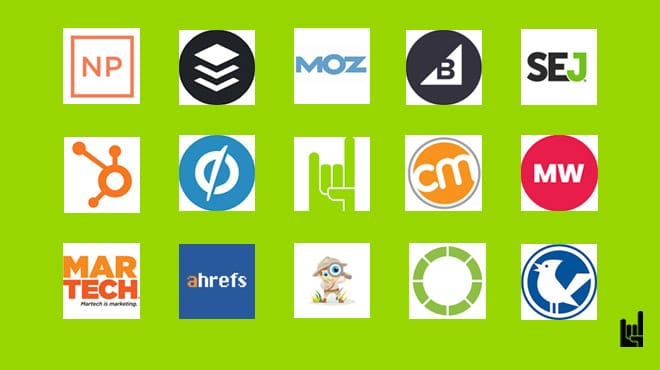

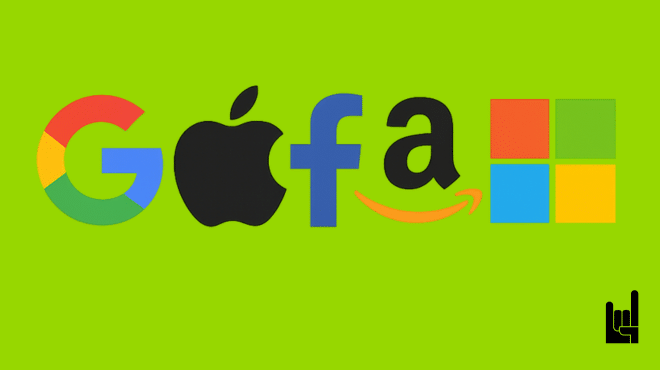

3 Responses
A truly great blog, love the information you provided on startup success factors!
Thanks, Aaron! o/\o
Its really commendable article and has helped me a lot in understanding in which direction I should move to get Vc funding. Its right on the money.